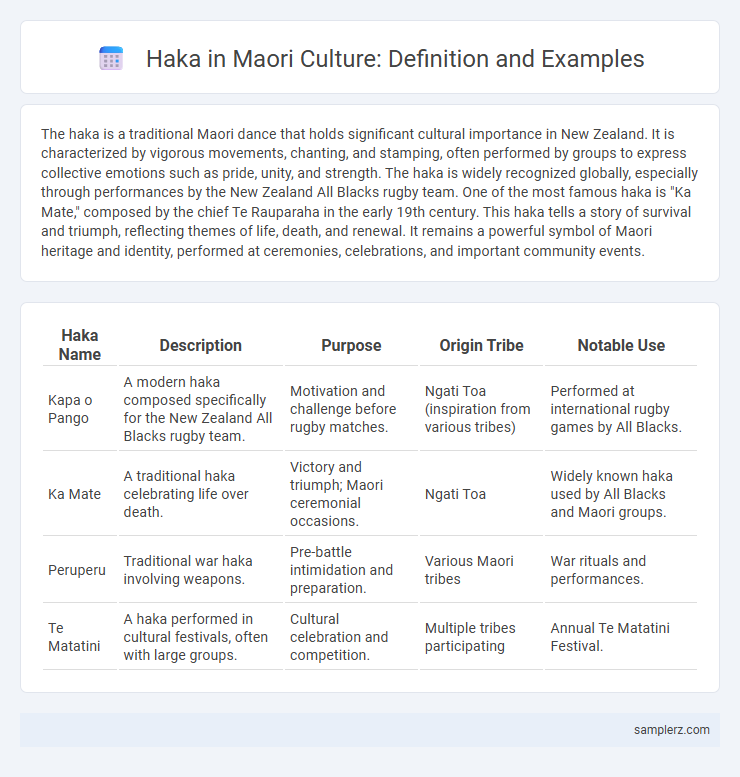The haka is a traditional Maori dance that holds significant cultural importance in New Zealand. It is characterized by vigorous movements, chanting, and stamping, often performed by groups to express collective emotions such as pride, unity, and strength. The haka is widely recognized globally, especially through performances by the New Zealand All Blacks rugby team. One of the most famous haka is "Ka Mate," composed by the chief Te Rauparaha in the early 19th century. This haka tells a story of survival and triumph, reflecting themes of life, death, and renewal. It remains a powerful symbol of Maori heritage and identity, performed at ceremonies, celebrations, and important community events.
Table of Comparison
| Haka Name | Description | Purpose | Origin Tribe | Notable Use |
|---|---|---|---|---|
| Kapa o Pango | A modern haka composed specifically for the New Zealand All Blacks rugby team. | Motivation and challenge before rugby matches. | Ngati Toa (inspiration from various tribes) | Performed at international rugby games by All Blacks. |
| Ka Mate | A traditional haka celebrating life over death. | Victory and triumph; Maori ceremonial occasions. | Ngati Toa | Widely known haka used by All Blacks and Maori groups. |
| Peruperu | Traditional war haka involving weapons. | Pre-battle intimidation and preparation. | Various Maori tribes | War rituals and performances. |
| Te Matatini | A haka performed in cultural festivals, often with large groups. | Cultural celebration and competition. | Multiple tribes participating | Annual Te Matatini Festival. |
Origins and Significance of the Haka in Māori Culture
The haka, a traditional Maori war dance, originated from ancient Maori warrior culture as a powerful expression of strength, unity, and identity. It serves as both a challenge to opponents and a ceremonial display during important events, symbolizing tribal pride and ancestral heritage. The haka remains a vital cultural practice that reinforces communal bonds and preserves the spiritual connection to Maori ancestors.
Traditional Haka: A Window into Māori Heritage
The traditional haka, a powerful Maori dance, serves as a profound expression of tribal identity, history, and values. Performed with vigorous movements, rhythmic chanting, and facial expressions like the protruding tongue and wide eyes, the haka embodies the spiritual connection between Maori ancestors and the living community. This cultural practice, deeply rooted in Aotearoa New Zealand's heritage, remains a vital symbol of unity, strength, and resilience among Maori people.
The Role of Haka in Māori Ceremonies and Rituals
The haka plays a vital role in Maori ceremonies and rituals, serving as a powerful expression of identity, unity, and ancestral connection. Performed during significant events such as powhiri (welcoming ceremonies), tangihanga (funerals), and celebrations, the haka communicates respect, strength, and collective emotion. Its choreographed movements and vocalizations convey stories and cultural values, reinforcing social bonds within the Maori community.
Types of Haka: From War Dances to Celebratory Performances
Haka, a traditional Maori war dance, encompasses various types such as the fierce peruperu performed with weapons, the powhiri haka used during welcoming ceremonies, and the celebratory haka kapa o pango popularized by New Zealand rugby. These diverse forms serve distinct cultural purposes, ranging from invoking strength and unity in battle to honoring guests and celebrating achievements. Each haka type reflects rich Maori heritage and expresses collective identity through powerful chants, rhythmic movements, and facial expressions.
Ka Mate: The Most Famous Māori Haka
Ka Mate is the most famous Maori haka, composed by the chief Te Rauparaha in the early 19th century. This haka is a powerful war dance performed to display strength, unity, and pride, often characterized by vigorous movements and chanting. Its global recognition increased significantly when the New Zealand All Blacks rugby team adopted it as a pre-match ritual, symbolizing Maori culture and identity.
Peruperu: The Traditional War Haka
The Peruperu is a traditional Maori war haka performed by warriors before battle to demonstrate strength, unity, and intimidation. Characterized by vigorous stomping, fierce facial expressions including bulging eyes and protruding tongues, and coordinated movements, the Peruperu evokes ancestral warrior spirits. It holds deep cultural significance, preserving Maori heritage and conveying messages of courage and resistance through powerful chants and dynamic gestures.
Haka Powhiri: Welcoming Guests with Respect
Haka Powhiri is a traditional Maori war dance performed to welcome guests with respect and honor. This ceremonial haka involves powerful gestures, vocal chants, and expressions that symbolize strength, unity, and hospitality. It plays a vital role in Maori culture, emphasizing the importance of manaakitanga, or caring hospitality, during formal gatherings.
Haka in Modern New Zealand Society
Haka, a traditional Maori war dance characterized by powerful movements and chanting, plays a significant role in modern New Zealand society as a symbol of cultural identity and unity. It is prominently performed at national rugby matches by the All Blacks, showcasing Maori heritage on the global stage. Beyond sports, haka is integrated into ceremonies, protests, and celebrations, reflecting its ongoing cultural relevance and respect within New Zealand's diverse communities.
Haka Performed by Sports Teams: A Symbol of Unity
The haka performed by Maori sports teams, notably the All Blacks rugby team, serves as a powerful symbol of unity, strength, and cultural pride. This traditional war dance incorporates rhythmic stomping, chanting, and fierce facial expressions, embodying collective identity and respect for Maori heritage. Sporting haka unites players and fans alike, fostering a strong sense of solidarity and shared purpose on the international stage.
Haka in Global Events and International Recognition
The haka, a traditional Maori war dance, has gained global prominence through its powerful performances at international events such as Rugby World Cup matches, where the New Zealand All Blacks captivate audiences worldwide. This cultural expression symbolizes Maori heritage and identity, promoting cross-cultural understanding and respect on a global stage. International recognition of the haka fosters awareness of indigenous traditions and enhances its role in cultural diplomacy and New Zealand's national branding.

example of haka in Maori Infographic
 samplerz.com
samplerz.com